RKC July 2017 MBA Leadership and Sustainability Dissertation Proposal
VerifiedAdded on 2019/09/20
|11
|3918
|295
Report
AI Summary
This MBA dissertation proposal examines the impact of leadership styles on a medical device group following a merger and acquisition, and a subsequent product recall. The research investigates the transition of a company from separated business units to a unified entity with a new leadership tea...
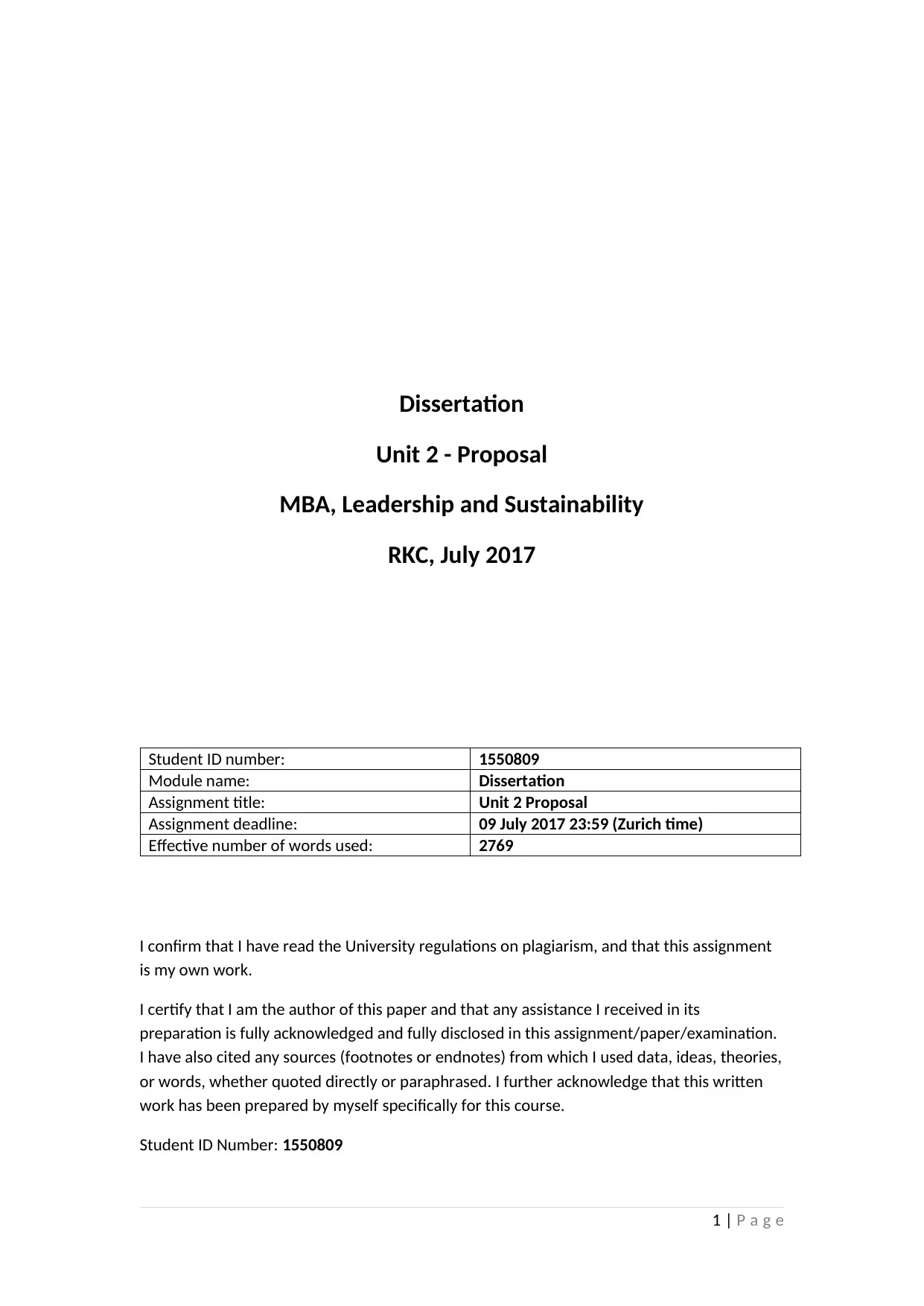
Dissertation
Unit 2 - Proposal
MBA, Leadership and Sustainability
RKC, July 2017
Student ID number: 1550809
Module name: Dissertation
Assignment title: Unit 2 Proposal
Assignment deadline: 09 July 2017 23:59 (Zurich time)
Effective number of words used: 2769
I confirm that I have read the University regulations on plagiarism, and that this assignment
is my own work.
I certify that I am the author of this paper and that any assistance I received in its
preparation is fully acknowledged and fully disclosed in this assignment/paper/examination.
I have also cited any sources (footnotes or endnotes) from which I used data, ideas, theories,
or words, whether quoted directly or paraphrased. I further acknowledge that this written
work has been prepared by myself specifically for this course.
Student ID Number: 1550809
1 | P a g e
Unit 2 - Proposal
MBA, Leadership and Sustainability
RKC, July 2017
Student ID number: 1550809
Module name: Dissertation
Assignment title: Unit 2 Proposal
Assignment deadline: 09 July 2017 23:59 (Zurich time)
Effective number of words used: 2769
I confirm that I have read the University regulations on plagiarism, and that this assignment
is my own work.
I certify that I am the author of this paper and that any assistance I received in its
preparation is fully acknowledged and fully disclosed in this assignment/paper/examination.
I have also cited any sources (footnotes or endnotes) from which I used data, ideas, theories,
or words, whether quoted directly or paraphrased. I further acknowledge that this written
work has been prepared by myself specifically for this course.
Student ID Number: 1550809
1 | P a g e
Paraphrase This Document
Need a fresh take? Get an instant paraphrase of this document with our AI Paraphraser
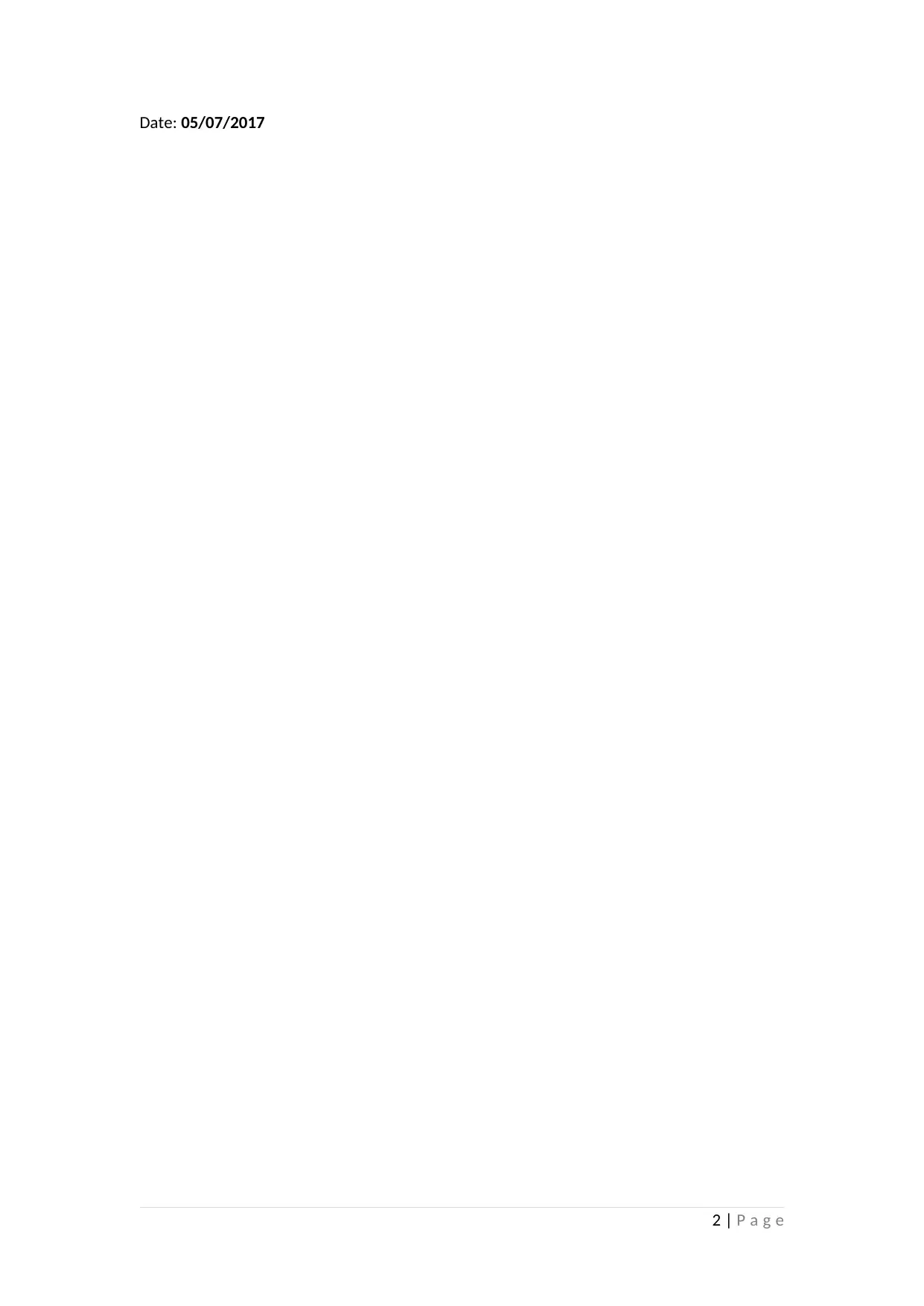
Date: 05/07/2017
2 | P a g e
2 | P a g e
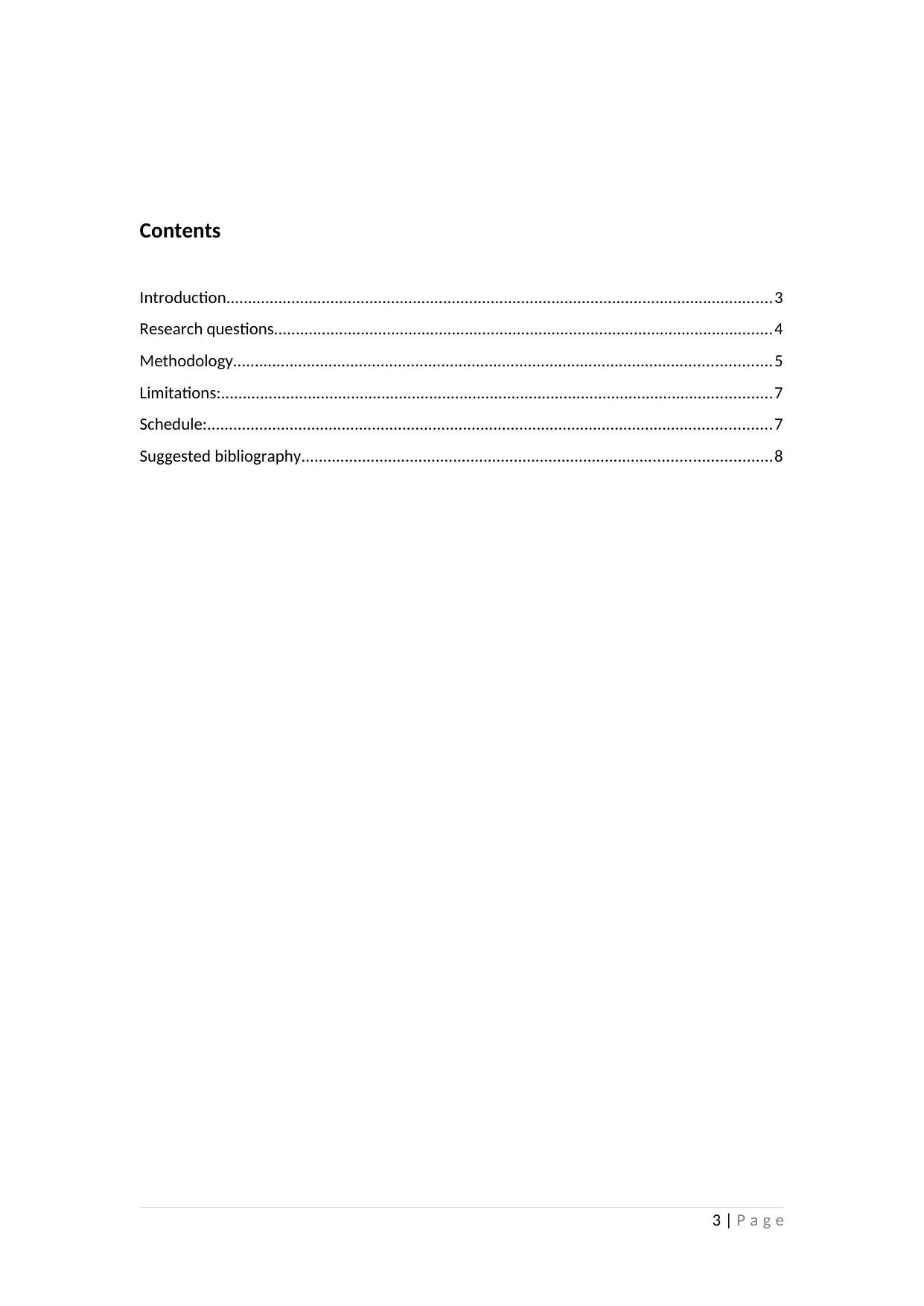
Contents
Introduction..............................................................................................................................3
Research questions...................................................................................................................4
Methodology............................................................................................................................5
Limitations:...............................................................................................................................7
Schedule:..................................................................................................................................7
Suggested bibliography............................................................................................................8
3 | P a g e
Introduction..............................................................................................................................3
Research questions...................................................................................................................4
Methodology............................................................................................................................5
Limitations:...............................................................................................................................7
Schedule:..................................................................................................................................7
Suggested bibliography............................................................................................................8
3 | P a g e
⊘ This is a preview!⊘
Do you want full access?
Subscribe today to unlock all pages.

Trusted by 1+ million students worldwide
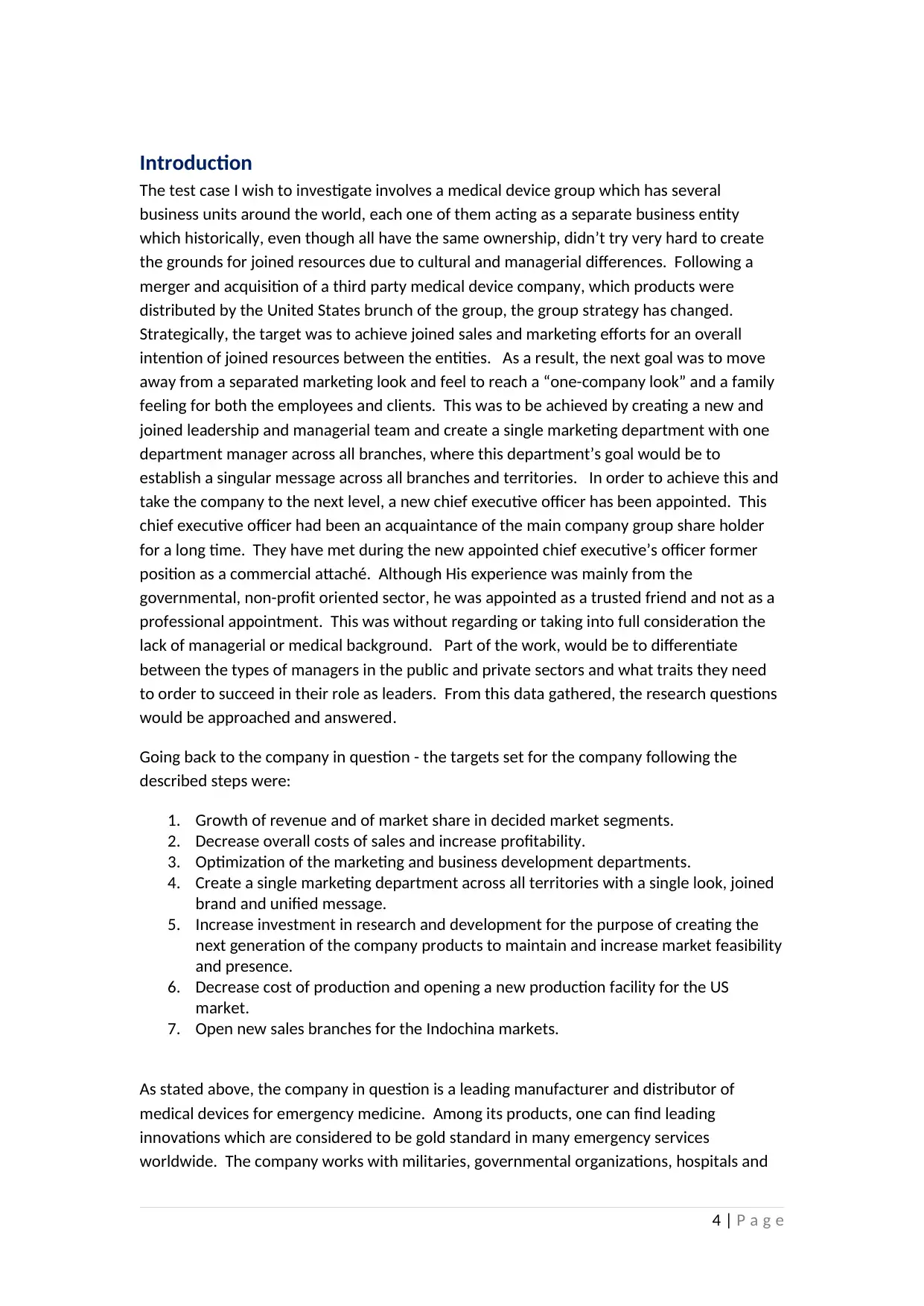
Introduction
The test case I wish to investigate involves a medical device group which has several
business units around the world, each one of them acting as a separate business entity
which historically, even though all have the same ownership, didn’t try very hard to create
the grounds for joined resources due to cultural and managerial differences. Following a
merger and acquisition of a third party medical device company, which products were
distributed by the United States brunch of the group, the group strategy has changed.
Strategically, the target was to achieve joined sales and marketing efforts for an overall
intention of joined resources between the entities. As a result, the next goal was to move
away from a separated marketing look and feel to reach a “one-company look” and a family
feeling for both the employees and clients. This was to be achieved by creating a new and
joined leadership and managerial team and create a single marketing department with one
department manager across all branches, where this department’s goal would be to
establish a singular message across all branches and territories. In order to achieve this and
take the company to the next level, a new chief executive officer has been appointed. This
chief executive officer had been an acquaintance of the main company group share holder
for a long time. They have met during the new appointed chief executive’s officer former
position as a commercial attaché. Although His experience was mainly from the
governmental, non-profit oriented sector, he was appointed as a trusted friend and not as a
professional appointment. This was without regarding or taking into full consideration the
lack of managerial or medical background. Part of the work, would be to differentiate
between the types of managers in the public and private sectors and what traits they need
to order to succeed in their role as leaders. From this data gathered, the research questions
would be approached and answered.
Going back to the company in question - the targets set for the company following the
described steps were:
1. Growth of revenue and of market share in decided market segments.
2. Decrease overall costs of sales and increase profitability.
3. Optimization of the marketing and business development departments.
4. Create a single marketing department across all territories with a single look, joined
brand and unified message.
5. Increase investment in research and development for the purpose of creating the
next generation of the company products to maintain and increase market feasibility
and presence.
6. Decrease cost of production and opening a new production facility for the US
market.
7. Open new sales branches for the Indochina markets.
As stated above, the company in question is a leading manufacturer and distributor of
medical devices for emergency medicine. Among its products, one can find leading
innovations which are considered to be gold standard in many emergency services
worldwide. The company works with militaries, governmental organizations, hospitals and
4 | P a g e
The test case I wish to investigate involves a medical device group which has several
business units around the world, each one of them acting as a separate business entity
which historically, even though all have the same ownership, didn’t try very hard to create
the grounds for joined resources due to cultural and managerial differences. Following a
merger and acquisition of a third party medical device company, which products were
distributed by the United States brunch of the group, the group strategy has changed.
Strategically, the target was to achieve joined sales and marketing efforts for an overall
intention of joined resources between the entities. As a result, the next goal was to move
away from a separated marketing look and feel to reach a “one-company look” and a family
feeling for both the employees and clients. This was to be achieved by creating a new and
joined leadership and managerial team and create a single marketing department with one
department manager across all branches, where this department’s goal would be to
establish a singular message across all branches and territories. In order to achieve this and
take the company to the next level, a new chief executive officer has been appointed. This
chief executive officer had been an acquaintance of the main company group share holder
for a long time. They have met during the new appointed chief executive’s officer former
position as a commercial attaché. Although His experience was mainly from the
governmental, non-profit oriented sector, he was appointed as a trusted friend and not as a
professional appointment. This was without regarding or taking into full consideration the
lack of managerial or medical background. Part of the work, would be to differentiate
between the types of managers in the public and private sectors and what traits they need
to order to succeed in their role as leaders. From this data gathered, the research questions
would be approached and answered.
Going back to the company in question - the targets set for the company following the
described steps were:
1. Growth of revenue and of market share in decided market segments.
2. Decrease overall costs of sales and increase profitability.
3. Optimization of the marketing and business development departments.
4. Create a single marketing department across all territories with a single look, joined
brand and unified message.
5. Increase investment in research and development for the purpose of creating the
next generation of the company products to maintain and increase market feasibility
and presence.
6. Decrease cost of production and opening a new production facility for the US
market.
7. Open new sales branches for the Indochina markets.
As stated above, the company in question is a leading manufacturer and distributor of
medical devices for emergency medicine. Among its products, one can find leading
innovations which are considered to be gold standard in many emergency services
worldwide. The company works with militaries, governmental organizations, hospitals and
4 | P a g e
Paraphrase This Document
Need a fresh take? Get an instant paraphrase of this document with our AI Paraphraser
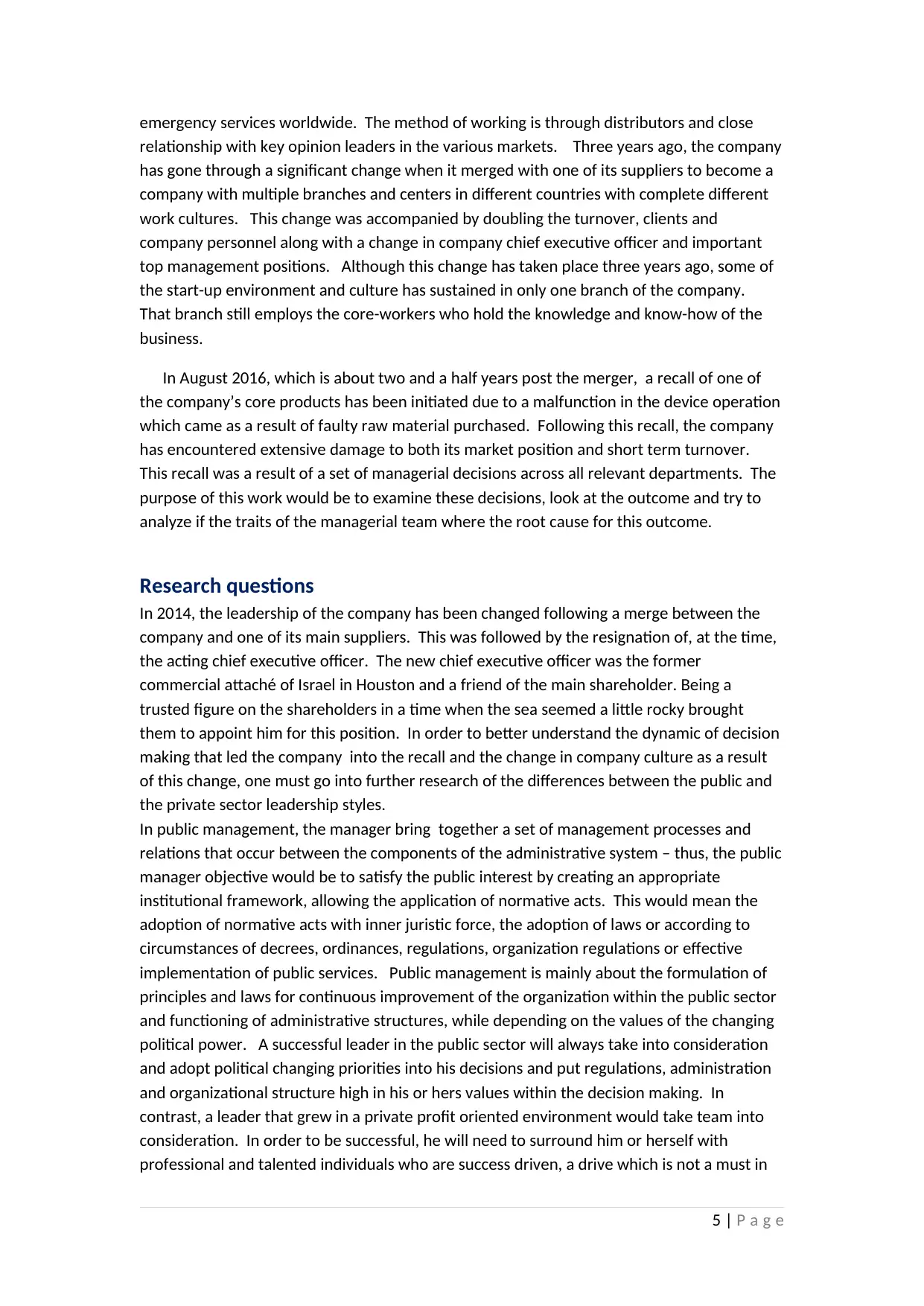
emergency services worldwide. The method of working is through distributors and close
relationship with key opinion leaders in the various markets. Three years ago, the company
has gone through a significant change when it merged with one of its suppliers to become a
company with multiple branches and centers in different countries with complete different
work cultures. This change was accompanied by doubling the turnover, clients and
company personnel along with a change in company chief executive officer and important
top management positions. Although this change has taken place three years ago, some of
the start-up environment and culture has sustained in only one branch of the company.
That branch still employs the core-workers who hold the knowledge and know-how of the
business.
In August 2016, which is about two and a half years post the merger, a recall of one of
the company’s core products has been initiated due to a malfunction in the device operation
which came as a result of faulty raw material purchased. Following this recall, the company
has encountered extensive damage to both its market position and short term turnover.
This recall was a result of a set of managerial decisions across all relevant departments. The
purpose of this work would be to examine these decisions, look at the outcome and try to
analyze if the traits of the managerial team where the root cause for this outcome.
Research questions
In 2014, the leadership of the company has been changed following a merge between the
company and one of its main suppliers. This was followed by the resignation of, at the time,
the acting chief executive officer. The new chief executive officer was the former
commercial attaché of Israel in Houston and a friend of the main shareholder. Being a
trusted figure on the shareholders in a time when the sea seemed a little rocky brought
them to appoint him for this position. In order to better understand the dynamic of decision
making that led the company into the recall and the change in company culture as a result
of this change, one must go into further research of the differences between the public and
the private sector leadership styles.
In public management, the manager bring together a set of management processes and
relations that occur between the components of the administrative system – thus, the public
manager objective would be to satisfy the public interest by creating an appropriate
institutional framework, allowing the application of normative acts. This would mean the
adoption of normative acts with inner juristic force, the adoption of laws or according to
circumstances of decrees, ordinances, regulations, organization regulations or effective
implementation of public services. Public management is mainly about the formulation of
principles and laws for continuous improvement of the organization within the public sector
and functioning of administrative structures, while depending on the values of the changing
political power. A successful leader in the public sector will always take into consideration
and adopt political changing priorities into his decisions and put regulations, administration
and organizational structure high in his or hers values within the decision making. In
contrast, a leader that grew in a private profit oriented environment would take team into
consideration. In order to be successful, he will need to surround him or herself with
professional and talented individuals who are success driven, a drive which is not a must in
5 | P a g e
relationship with key opinion leaders in the various markets. Three years ago, the company
has gone through a significant change when it merged with one of its suppliers to become a
company with multiple branches and centers in different countries with complete different
work cultures. This change was accompanied by doubling the turnover, clients and
company personnel along with a change in company chief executive officer and important
top management positions. Although this change has taken place three years ago, some of
the start-up environment and culture has sustained in only one branch of the company.
That branch still employs the core-workers who hold the knowledge and know-how of the
business.
In August 2016, which is about two and a half years post the merger, a recall of one of
the company’s core products has been initiated due to a malfunction in the device operation
which came as a result of faulty raw material purchased. Following this recall, the company
has encountered extensive damage to both its market position and short term turnover.
This recall was a result of a set of managerial decisions across all relevant departments. The
purpose of this work would be to examine these decisions, look at the outcome and try to
analyze if the traits of the managerial team where the root cause for this outcome.
Research questions
In 2014, the leadership of the company has been changed following a merge between the
company and one of its main suppliers. This was followed by the resignation of, at the time,
the acting chief executive officer. The new chief executive officer was the former
commercial attaché of Israel in Houston and a friend of the main shareholder. Being a
trusted figure on the shareholders in a time when the sea seemed a little rocky brought
them to appoint him for this position. In order to better understand the dynamic of decision
making that led the company into the recall and the change in company culture as a result
of this change, one must go into further research of the differences between the public and
the private sector leadership styles.
In public management, the manager bring together a set of management processes and
relations that occur between the components of the administrative system – thus, the public
manager objective would be to satisfy the public interest by creating an appropriate
institutional framework, allowing the application of normative acts. This would mean the
adoption of normative acts with inner juristic force, the adoption of laws or according to
circumstances of decrees, ordinances, regulations, organization regulations or effective
implementation of public services. Public management is mainly about the formulation of
principles and laws for continuous improvement of the organization within the public sector
and functioning of administrative structures, while depending on the values of the changing
political power. A successful leader in the public sector will always take into consideration
and adopt political changing priorities into his decisions and put regulations, administration
and organizational structure high in his or hers values within the decision making. In
contrast, a leader that grew in a private profit oriented environment would take team into
consideration. In order to be successful, he will need to surround him or herself with
professional and talented individuals who are success driven, a drive which is not a must in
5 | P a g e
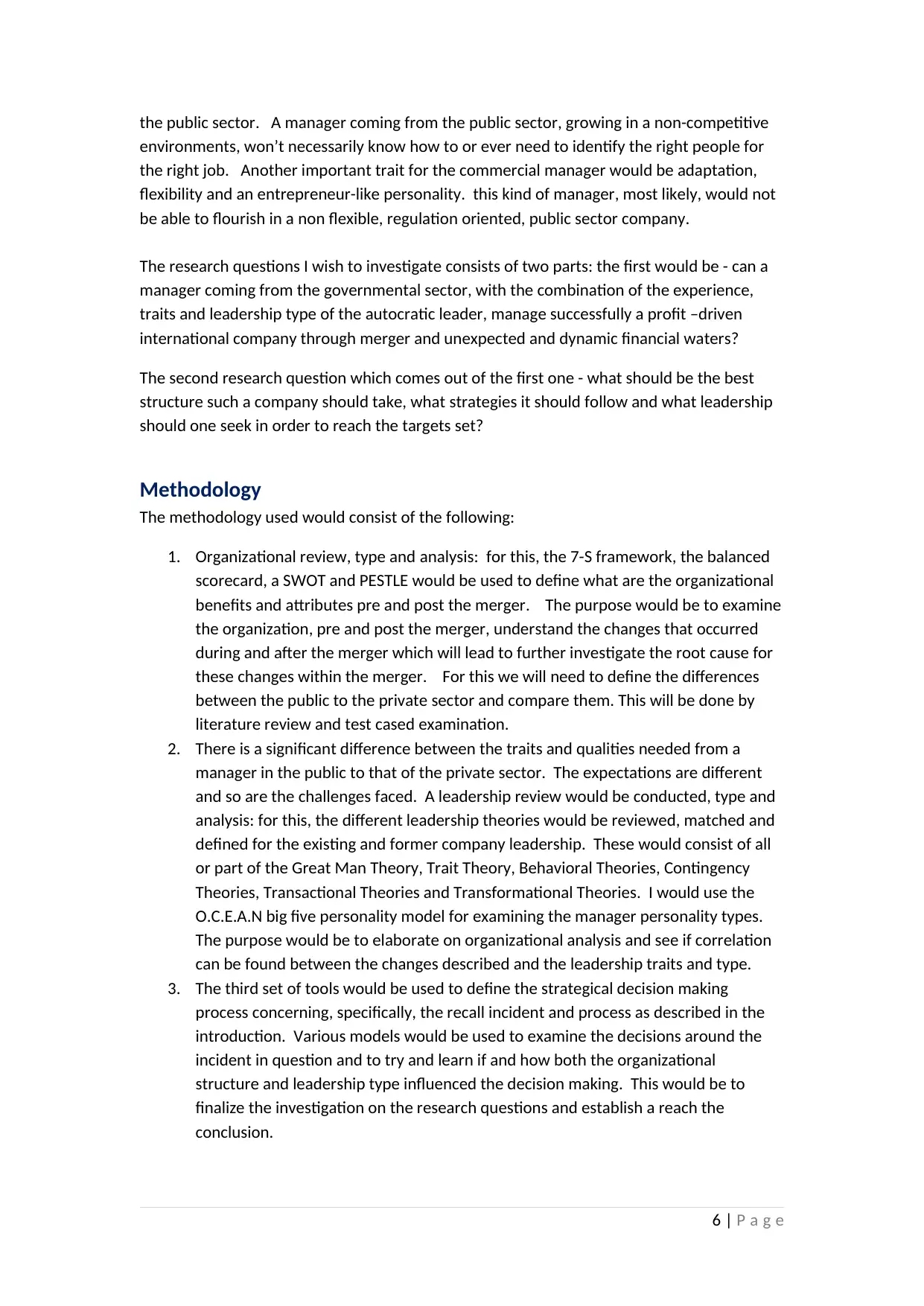
the public sector. A manager coming from the public sector, growing in a non-competitive
environments, won’t necessarily know how to or ever need to identify the right people for
the right job. Another important trait for the commercial manager would be adaptation,
flexibility and an entrepreneur-like personality. this kind of manager, most likely, would not
be able to flourish in a non flexible, regulation oriented, public sector company.
The research questions I wish to investigate consists of two parts: the first would be - can a
manager coming from the governmental sector, with the combination of the experience,
traits and leadership type of the autocratic leader, manage successfully a profit –driven
international company through merger and unexpected and dynamic financial waters?
The second research question which comes out of the first one - what should be the best
structure such a company should take, what strategies it should follow and what leadership
should one seek in order to reach the targets set?
Methodology
The methodology used would consist of the following:
1. Organizational review, type and analysis: for this, the 7-S framework, the balanced
scorecard, a SWOT and PESTLE would be used to define what are the organizational
benefits and attributes pre and post the merger. The purpose would be to examine
the organization, pre and post the merger, understand the changes that occurred
during and after the merger which will lead to further investigate the root cause for
these changes within the merger. For this we will need to define the differences
between the public to the private sector and compare them. This will be done by
literature review and test cased examination.
2. There is a significant difference between the traits and qualities needed from a
manager in the public to that of the private sector. The expectations are different
and so are the challenges faced. A leadership review would be conducted, type and
analysis: for this, the different leadership theories would be reviewed, matched and
defined for the existing and former company leadership. These would consist of all
or part of the Great Man Theory, Trait Theory, Behavioral Theories, Contingency
Theories, Transactional Theories and Transformational Theories. I would use the
O.C.E.A.N big five personality model for examining the manager personality types.
The purpose would be to elaborate on organizational analysis and see if correlation
can be found between the changes described and the leadership traits and type.
3. The third set of tools would be used to define the strategical decision making
process concerning, specifically, the recall incident and process as described in the
introduction. Various models would be used to examine the decisions around the
incident in question and to try and learn if and how both the organizational
structure and leadership type influenced the decision making. This would be to
finalize the investigation on the research questions and establish a reach the
conclusion.
6 | P a g e
environments, won’t necessarily know how to or ever need to identify the right people for
the right job. Another important trait for the commercial manager would be adaptation,
flexibility and an entrepreneur-like personality. this kind of manager, most likely, would not
be able to flourish in a non flexible, regulation oriented, public sector company.
The research questions I wish to investigate consists of two parts: the first would be - can a
manager coming from the governmental sector, with the combination of the experience,
traits and leadership type of the autocratic leader, manage successfully a profit –driven
international company through merger and unexpected and dynamic financial waters?
The second research question which comes out of the first one - what should be the best
structure such a company should take, what strategies it should follow and what leadership
should one seek in order to reach the targets set?
Methodology
The methodology used would consist of the following:
1. Organizational review, type and analysis: for this, the 7-S framework, the balanced
scorecard, a SWOT and PESTLE would be used to define what are the organizational
benefits and attributes pre and post the merger. The purpose would be to examine
the organization, pre and post the merger, understand the changes that occurred
during and after the merger which will lead to further investigate the root cause for
these changes within the merger. For this we will need to define the differences
between the public to the private sector and compare them. This will be done by
literature review and test cased examination.
2. There is a significant difference between the traits and qualities needed from a
manager in the public to that of the private sector. The expectations are different
and so are the challenges faced. A leadership review would be conducted, type and
analysis: for this, the different leadership theories would be reviewed, matched and
defined for the existing and former company leadership. These would consist of all
or part of the Great Man Theory, Trait Theory, Behavioral Theories, Contingency
Theories, Transactional Theories and Transformational Theories. I would use the
O.C.E.A.N big five personality model for examining the manager personality types.
The purpose would be to elaborate on organizational analysis and see if correlation
can be found between the changes described and the leadership traits and type.
3. The third set of tools would be used to define the strategical decision making
process concerning, specifically, the recall incident and process as described in the
introduction. Various models would be used to examine the decisions around the
incident in question and to try and learn if and how both the organizational
structure and leadership type influenced the decision making. This would be to
finalize the investigation on the research questions and establish a reach the
conclusion.
6 | P a g e
⊘ This is a preview!⊘
Do you want full access?
Subscribe today to unlock all pages.

Trusted by 1+ million students worldwide
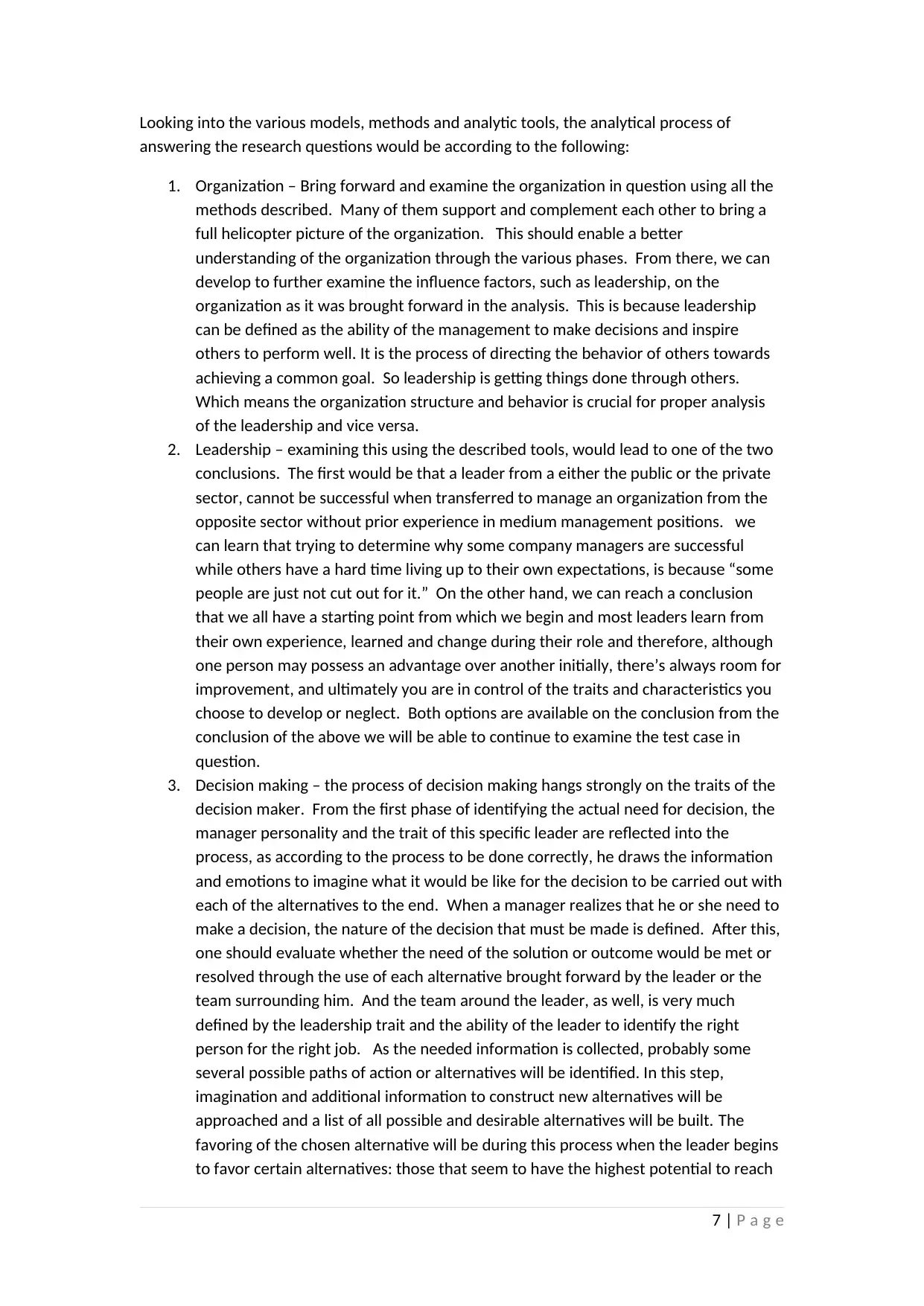
Looking into the various models, methods and analytic tools, the analytical process of
answering the research questions would be according to the following:
1. Organization – Bring forward and examine the organization in question using all the
methods described. Many of them support and complement each other to bring a
full helicopter picture of the organization. This should enable a better
understanding of the organization through the various phases. From there, we can
develop to further examine the influence factors, such as leadership, on the
organization as it was brought forward in the analysis. This is because leadership
can be defined as the ability of the management to make decisions and inspire
others to perform well. It is the process of directing the behavior of others towards
achieving a common goal. So leadership is getting things done through others.
Which means the organization structure and behavior is crucial for proper analysis
of the leadership and vice versa.
2. Leadership – examining this using the described tools, would lead to one of the two
conclusions. The first would be that a leader from a either the public or the private
sector, cannot be successful when transferred to manage an organization from the
opposite sector without prior experience in medium management positions. we
can learn that trying to determine why some company managers are successful
while others have a hard time living up to their own expectations, is because “some
people are just not cut out for it.” On the other hand, we can reach a conclusion
that we all have a starting point from which we begin and most leaders learn from
their own experience, learned and change during their role and therefore, although
one person may possess an advantage over another initially, there’s always room for
improvement, and ultimately you are in control of the traits and characteristics you
choose to develop or neglect. Both options are available on the conclusion from the
conclusion of the above we will be able to continue to examine the test case in
question.
3. Decision making – the process of decision making hangs strongly on the traits of the
decision maker. From the first phase of identifying the actual need for decision, the
manager personality and the trait of this specific leader are reflected into the
process, as according to the process to be done correctly, he draws the information
and emotions to imagine what it would be like for the decision to be carried out with
each of the alternatives to the end. When a manager realizes that he or she need to
make a decision, the nature of the decision that must be made is defined. After this,
one should evaluate whether the need of the solution or outcome would be met or
resolved through the use of each alternative brought forward by the leader or the
team surrounding him. And the team around the leader, as well, is very much
defined by the leadership trait and the ability of the leader to identify the right
person for the right job. As the needed information is collected, probably some
several possible paths of action or alternatives will be identified. In this step,
imagination and additional information to construct new alternatives will be
approached and a list of all possible and desirable alternatives will be built. The
favoring of the chosen alternative will be during this process when the leader begins
to favor certain alternatives: those that seem to have the highest potential to reach
7 | P a g e
answering the research questions would be according to the following:
1. Organization – Bring forward and examine the organization in question using all the
methods described. Many of them support and complement each other to bring a
full helicopter picture of the organization. This should enable a better
understanding of the organization through the various phases. From there, we can
develop to further examine the influence factors, such as leadership, on the
organization as it was brought forward in the analysis. This is because leadership
can be defined as the ability of the management to make decisions and inspire
others to perform well. It is the process of directing the behavior of others towards
achieving a common goal. So leadership is getting things done through others.
Which means the organization structure and behavior is crucial for proper analysis
of the leadership and vice versa.
2. Leadership – examining this using the described tools, would lead to one of the two
conclusions. The first would be that a leader from a either the public or the private
sector, cannot be successful when transferred to manage an organization from the
opposite sector without prior experience in medium management positions. we
can learn that trying to determine why some company managers are successful
while others have a hard time living up to their own expectations, is because “some
people are just not cut out for it.” On the other hand, we can reach a conclusion
that we all have a starting point from which we begin and most leaders learn from
their own experience, learned and change during their role and therefore, although
one person may possess an advantage over another initially, there’s always room for
improvement, and ultimately you are in control of the traits and characteristics you
choose to develop or neglect. Both options are available on the conclusion from the
conclusion of the above we will be able to continue to examine the test case in
question.
3. Decision making – the process of decision making hangs strongly on the traits of the
decision maker. From the first phase of identifying the actual need for decision, the
manager personality and the trait of this specific leader are reflected into the
process, as according to the process to be done correctly, he draws the information
and emotions to imagine what it would be like for the decision to be carried out with
each of the alternatives to the end. When a manager realizes that he or she need to
make a decision, the nature of the decision that must be made is defined. After this,
one should evaluate whether the need of the solution or outcome would be met or
resolved through the use of each alternative brought forward by the leader or the
team surrounding him. And the team around the leader, as well, is very much
defined by the leadership trait and the ability of the leader to identify the right
person for the right job. As the needed information is collected, probably some
several possible paths of action or alternatives will be identified. In this step,
imagination and additional information to construct new alternatives will be
approached and a list of all possible and desirable alternatives will be built. The
favoring of the chosen alternative will be during this process when the leader begins
to favor certain alternatives: those that seem to have the highest potential to reach
7 | P a g e
Paraphrase This Document
Need a fresh take? Get an instant paraphrase of this document with our AI Paraphraser
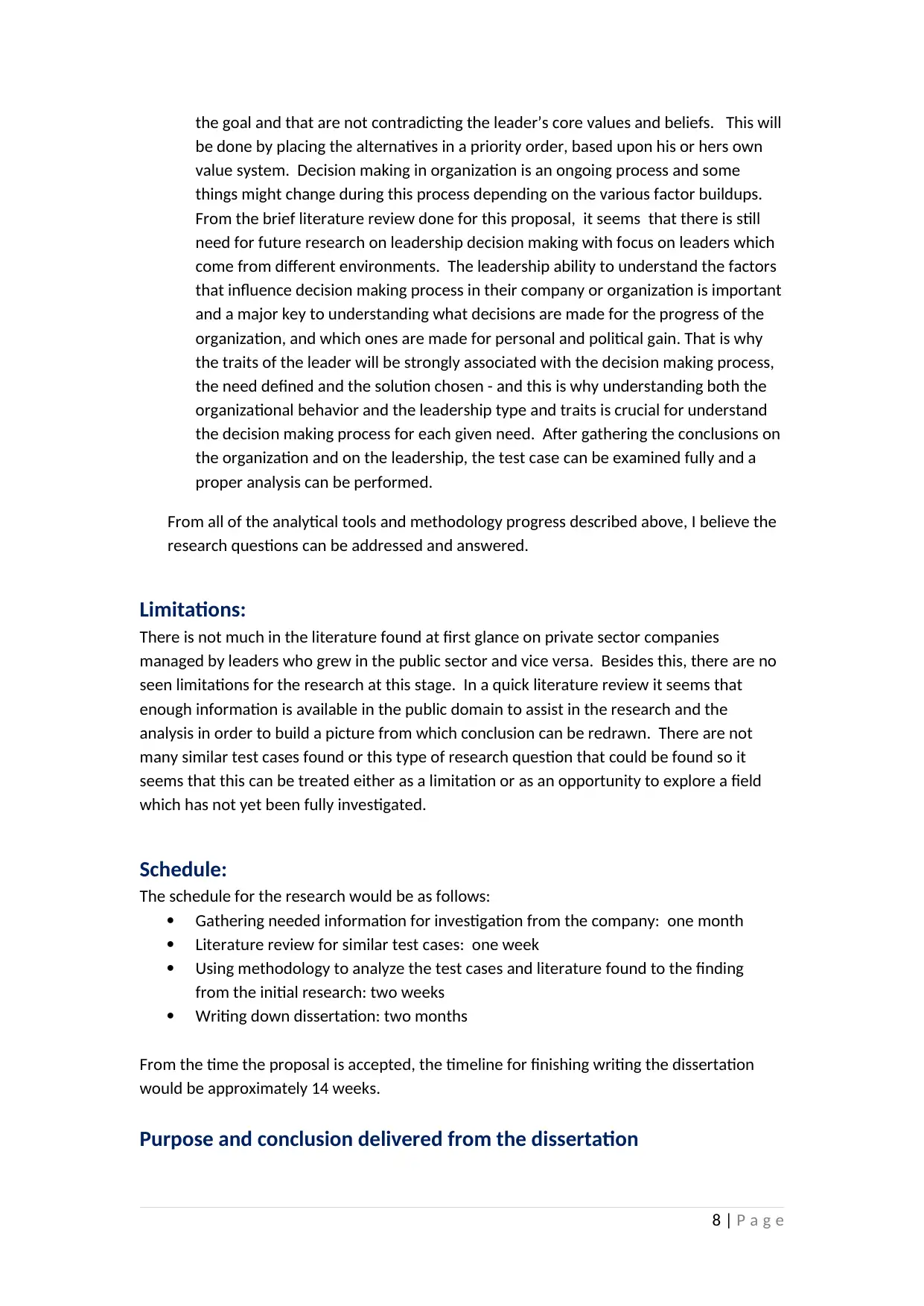
the goal and that are not contradicting the leader’s core values and beliefs. This will
be done by placing the alternatives in a priority order, based upon his or hers own
value system. Decision making in organization is an ongoing process and some
things might change during this process depending on the various factor buildups.
From the brief literature review done for this proposal, it seems that there is still
need for future research on leadership decision making with focus on leaders which
come from different environments. The leadership ability to understand the factors
that influence decision making process in their company or organization is important
and a major key to understanding what decisions are made for the progress of the
organization, and which ones are made for personal and political gain. That is why
the traits of the leader will be strongly associated with the decision making process,
the need defined and the solution chosen - and this is why understanding both the
organizational behavior and the leadership type and traits is crucial for understand
the decision making process for each given need. After gathering the conclusions on
the organization and on the leadership, the test case can be examined fully and a
proper analysis can be performed.
From all of the analytical tools and methodology progress described above, I believe the
research questions can be addressed and answered.
Limitations:
There is not much in the literature found at first glance on private sector companies
managed by leaders who grew in the public sector and vice versa. Besides this, there are no
seen limitations for the research at this stage. In a quick literature review it seems that
enough information is available in the public domain to assist in the research and the
analysis in order to build a picture from which conclusion can be redrawn. There are not
many similar test cases found or this type of research question that could be found so it
seems that this can be treated either as a limitation or as an opportunity to explore a field
which has not yet been fully investigated.
Schedule:
The schedule for the research would be as follows:
Gathering needed information for investigation from the company: one month
Literature review for similar test cases: one week
Using methodology to analyze the test cases and literature found to the finding
from the initial research: two weeks
Writing down dissertation: two months
From the time the proposal is accepted, the timeline for finishing writing the dissertation
would be approximately 14 weeks.
Purpose and conclusion delivered from the dissertation
8 | P a g e
be done by placing the alternatives in a priority order, based upon his or hers own
value system. Decision making in organization is an ongoing process and some
things might change during this process depending on the various factor buildups.
From the brief literature review done for this proposal, it seems that there is still
need for future research on leadership decision making with focus on leaders which
come from different environments. The leadership ability to understand the factors
that influence decision making process in their company or organization is important
and a major key to understanding what decisions are made for the progress of the
organization, and which ones are made for personal and political gain. That is why
the traits of the leader will be strongly associated with the decision making process,
the need defined and the solution chosen - and this is why understanding both the
organizational behavior and the leadership type and traits is crucial for understand
the decision making process for each given need. After gathering the conclusions on
the organization and on the leadership, the test case can be examined fully and a
proper analysis can be performed.
From all of the analytical tools and methodology progress described above, I believe the
research questions can be addressed and answered.
Limitations:
There is not much in the literature found at first glance on private sector companies
managed by leaders who grew in the public sector and vice versa. Besides this, there are no
seen limitations for the research at this stage. In a quick literature review it seems that
enough information is available in the public domain to assist in the research and the
analysis in order to build a picture from which conclusion can be redrawn. There are not
many similar test cases found or this type of research question that could be found so it
seems that this can be treated either as a limitation or as an opportunity to explore a field
which has not yet been fully investigated.
Schedule:
The schedule for the research would be as follows:
Gathering needed information for investigation from the company: one month
Literature review for similar test cases: one week
Using methodology to analyze the test cases and literature found to the finding
from the initial research: two weeks
Writing down dissertation: two months
From the time the proposal is accepted, the timeline for finishing writing the dissertation
would be approximately 14 weeks.
Purpose and conclusion delivered from the dissertation
8 | P a g e
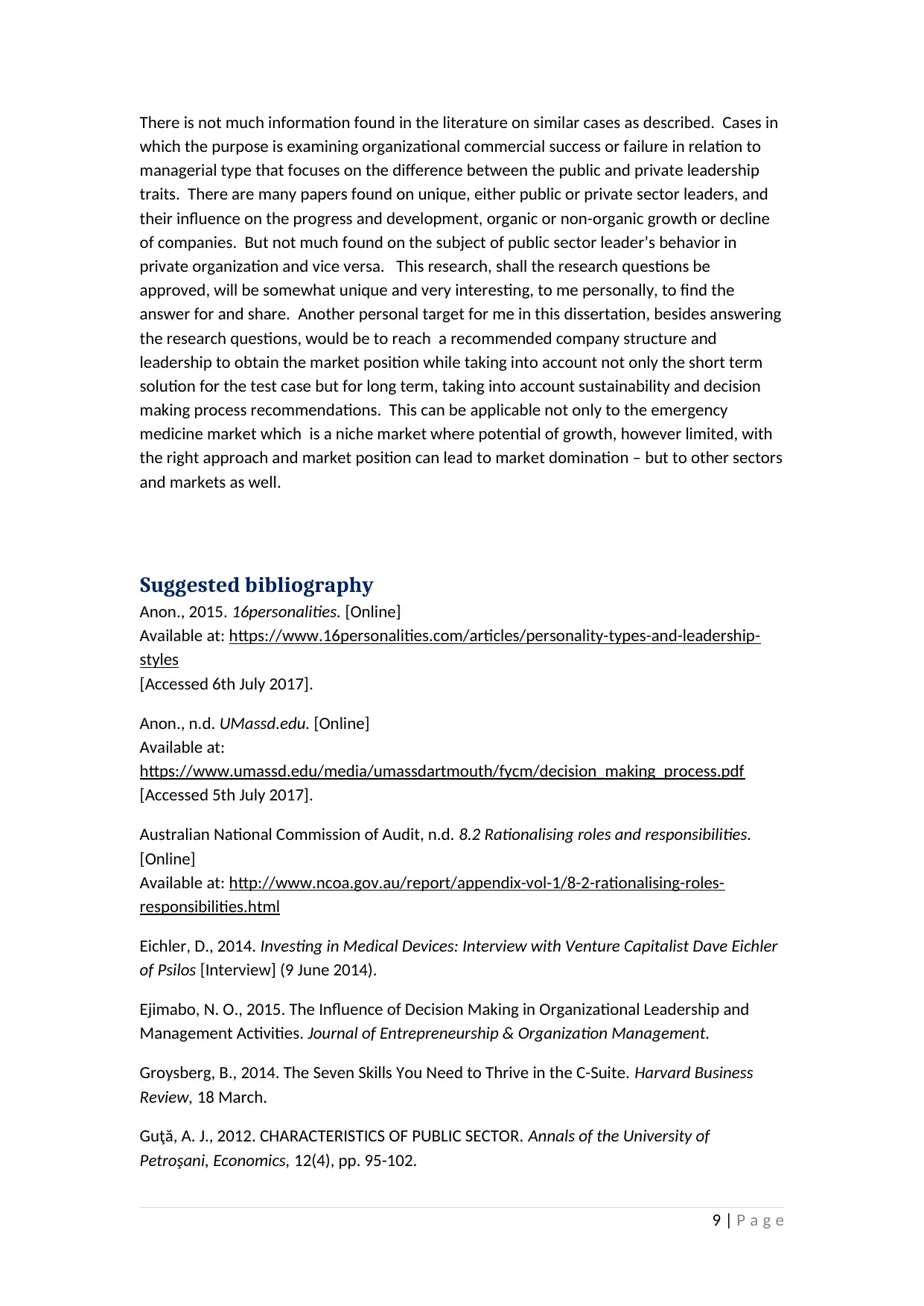
There is not much information found in the literature on similar cases as described. Cases in
which the purpose is examining organizational commercial success or failure in relation to
managerial type that focuses on the difference between the public and private leadership
traits. There are many papers found on unique, either public or private sector leaders, and
their influence on the progress and development, organic or non-organic growth or decline
of companies. But not much found on the subject of public sector leader’s behavior in
private organization and vice versa. This research, shall the research questions be
approved, will be somewhat unique and very interesting, to me personally, to find the
answer for and share. Another personal target for me in this dissertation, besides answering
the research questions, would be to reach a recommended company structure and
leadership to obtain the market position while taking into account not only the short term
solution for the test case but for long term, taking into account sustainability and decision
making process recommendations. This can be applicable not only to the emergency
medicine market which is a niche market where potential of growth, however limited, with
the right approach and market position can lead to market domination – but to other sectors
and markets as well.
Suggested bibliography
Anon., 2015. 16personalities. [Online]
Available at: https://www.16personalities.com/articles/personality-types-and-leadership-
styles
[Accessed 6th July 2017].
Anon., n.d. UMassd.edu. [Online]
Available at:
https://www.umassd.edu/media/umassdartmouth/fycm/decision_making_process.pdf
[Accessed 5th July 2017].
Australian National Commission of Audit, n.d. 8.2 Rationalising roles and responsibilities.
[Online]
Available at: http://www.ncoa.gov.au/report/appendix-vol-1/8-2-rationalising-roles-
responsibilities.html
Eichler, D., 2014. Investing in Medical Devices: Interview with Venture Capitalist Dave Eichler
of Psilos [Interview] (9 June 2014).
Ejimabo, N. O., 2015. The Influence of Decision Making in Organizational Leadership and
Management Activities. Journal of Entrepreneurship & Organization Management.
Groysberg, B., 2014. The Seven Skills You Need to Thrive in the C-Suite. Harvard Business
Review, 18 March.
Guţă, A. J., 2012. CHARACTERISTICS OF PUBLIC SECTOR. Annals of the University of
Petroşani, Economics, 12(4), pp. 95-102.
9 | P a g e
which the purpose is examining organizational commercial success or failure in relation to
managerial type that focuses on the difference between the public and private leadership
traits. There are many papers found on unique, either public or private sector leaders, and
their influence on the progress and development, organic or non-organic growth or decline
of companies. But not much found on the subject of public sector leader’s behavior in
private organization and vice versa. This research, shall the research questions be
approved, will be somewhat unique and very interesting, to me personally, to find the
answer for and share. Another personal target for me in this dissertation, besides answering
the research questions, would be to reach a recommended company structure and
leadership to obtain the market position while taking into account not only the short term
solution for the test case but for long term, taking into account sustainability and decision
making process recommendations. This can be applicable not only to the emergency
medicine market which is a niche market where potential of growth, however limited, with
the right approach and market position can lead to market domination – but to other sectors
and markets as well.
Suggested bibliography
Anon., 2015. 16personalities. [Online]
Available at: https://www.16personalities.com/articles/personality-types-and-leadership-
styles
[Accessed 6th July 2017].
Anon., n.d. UMassd.edu. [Online]
Available at:
https://www.umassd.edu/media/umassdartmouth/fycm/decision_making_process.pdf
[Accessed 5th July 2017].
Australian National Commission of Audit, n.d. 8.2 Rationalising roles and responsibilities.
[Online]
Available at: http://www.ncoa.gov.au/report/appendix-vol-1/8-2-rationalising-roles-
responsibilities.html
Eichler, D., 2014. Investing in Medical Devices: Interview with Venture Capitalist Dave Eichler
of Psilos [Interview] (9 June 2014).
Ejimabo, N. O., 2015. The Influence of Decision Making in Organizational Leadership and
Management Activities. Journal of Entrepreneurship & Organization Management.
Groysberg, B., 2014. The Seven Skills You Need to Thrive in the C-Suite. Harvard Business
Review, 18 March.
Guţă, A. J., 2012. CHARACTERISTICS OF PUBLIC SECTOR. Annals of the University of
Petroşani, Economics, 12(4), pp. 95-102.
9 | P a g e
⊘ This is a preview!⊘
Do you want full access?
Subscribe today to unlock all pages.

Trusted by 1+ million students worldwide

Harder, J., 1999. Primer On Orgenizational Culture, s.l.: University of Virgina.
Hitt, M. A. et al., 2009. Mergers and acquisitions: Overcoming pitfalls, building synergy, and
creating value. Elsevier.
Kaplan, R. S., 2010. Conceptual Foundations of the Balanced Scorecard: Working Paper, s.l.:
Harvard University.
Kaplan, R. S. & Norton, D. P., 1993. Putting the Balanced Scorecard to Work. Harvard
Business Review, Spetember- October.
keithtully, 2013. tweakyourbiz.com. [Online]
Available at: http://tweakyourbiz.com/management/2013/09/23/10-common-traits-of-a-
successful-company-director-do-you-have-these/
[Accessed 5th July 2017].
Lombardo, J., 2017. Study.com. [Online]
Available at: http://study.com/academy/lesson/the-big-five-personality-traits-workplace-
behavior.html
[Accessed 6th July 2017].
Mader, G., 2015. Why Are Leaders So Afraid of Change?. Entrepreneur, July.
Manktelow, J. & Carlson, A., n.d. Learn how to use the 7-S Framework, s.l.: Mindtools.
Marr, B., 2014. The 8 Signs of a Bad Leader. Entreprenour Middle East, 13 November.
Nautin, T., 2014. The aligned Organization. The Lean Management Enterprize, pp. 137-142.
Reevs, M. & Deimler, M., 2011. Adaptability: The new competitive advantage. July-August.
Richardson, S., 2009. [Online]
Available at: http://businessresultsrevolution.com/5-reasons-why-the-balanced-scorecard-
fails-in-organizations-and-how-to-prevent-it-from-happening-to/
Sidharth, T., 2010. Limitations of a PEST Analysis. [Online]
Available at: http://www.brighthubpm.com/project-planning/100700-limitations-of-a-pest-
analysis/
Srdjevic, Z., Bajcetic, R. & Srdjevic, B., 2012. Identifying the Criteria Set for Multicriteria
Decision Making Based on SWOT/PESTLE Analysis: A Case Study of Reconstructing A Water
Intake Structure. Water Resources Management, Septembner.pp. 3379-3393.
Taylor, N. F., 2016. SWOT Analysis: What It Is and When to Use It. Business News Daily, 1
April.
Vaughan, A., 2009. Environmental Legislation in the EU - What Medical Device
Mnaufactureres Need To Know. RAJ Devices, January/Febuary.pp. 3-8.
10 | P a g e
Hitt, M. A. et al., 2009. Mergers and acquisitions: Overcoming pitfalls, building synergy, and
creating value. Elsevier.
Kaplan, R. S., 2010. Conceptual Foundations of the Balanced Scorecard: Working Paper, s.l.:
Harvard University.
Kaplan, R. S. & Norton, D. P., 1993. Putting the Balanced Scorecard to Work. Harvard
Business Review, Spetember- October.
keithtully, 2013. tweakyourbiz.com. [Online]
Available at: http://tweakyourbiz.com/management/2013/09/23/10-common-traits-of-a-
successful-company-director-do-you-have-these/
[Accessed 5th July 2017].
Lombardo, J., 2017. Study.com. [Online]
Available at: http://study.com/academy/lesson/the-big-five-personality-traits-workplace-
behavior.html
[Accessed 6th July 2017].
Mader, G., 2015. Why Are Leaders So Afraid of Change?. Entrepreneur, July.
Manktelow, J. & Carlson, A., n.d. Learn how to use the 7-S Framework, s.l.: Mindtools.
Marr, B., 2014. The 8 Signs of a Bad Leader. Entreprenour Middle East, 13 November.
Nautin, T., 2014. The aligned Organization. The Lean Management Enterprize, pp. 137-142.
Reevs, M. & Deimler, M., 2011. Adaptability: The new competitive advantage. July-August.
Richardson, S., 2009. [Online]
Available at: http://businessresultsrevolution.com/5-reasons-why-the-balanced-scorecard-
fails-in-organizations-and-how-to-prevent-it-from-happening-to/
Sidharth, T., 2010. Limitations of a PEST Analysis. [Online]
Available at: http://www.brighthubpm.com/project-planning/100700-limitations-of-a-pest-
analysis/
Srdjevic, Z., Bajcetic, R. & Srdjevic, B., 2012. Identifying the Criteria Set for Multicriteria
Decision Making Based on SWOT/PESTLE Analysis: A Case Study of Reconstructing A Water
Intake Structure. Water Resources Management, Septembner.pp. 3379-3393.
Taylor, N. F., 2016. SWOT Analysis: What It Is and When to Use It. Business News Daily, 1
April.
Vaughan, A., 2009. Environmental Legislation in the EU - What Medical Device
Mnaufactureres Need To Know. RAJ Devices, January/Febuary.pp. 3-8.
10 | P a g e
Paraphrase This Document
Need a fresh take? Get an instant paraphrase of this document with our AI Paraphraser
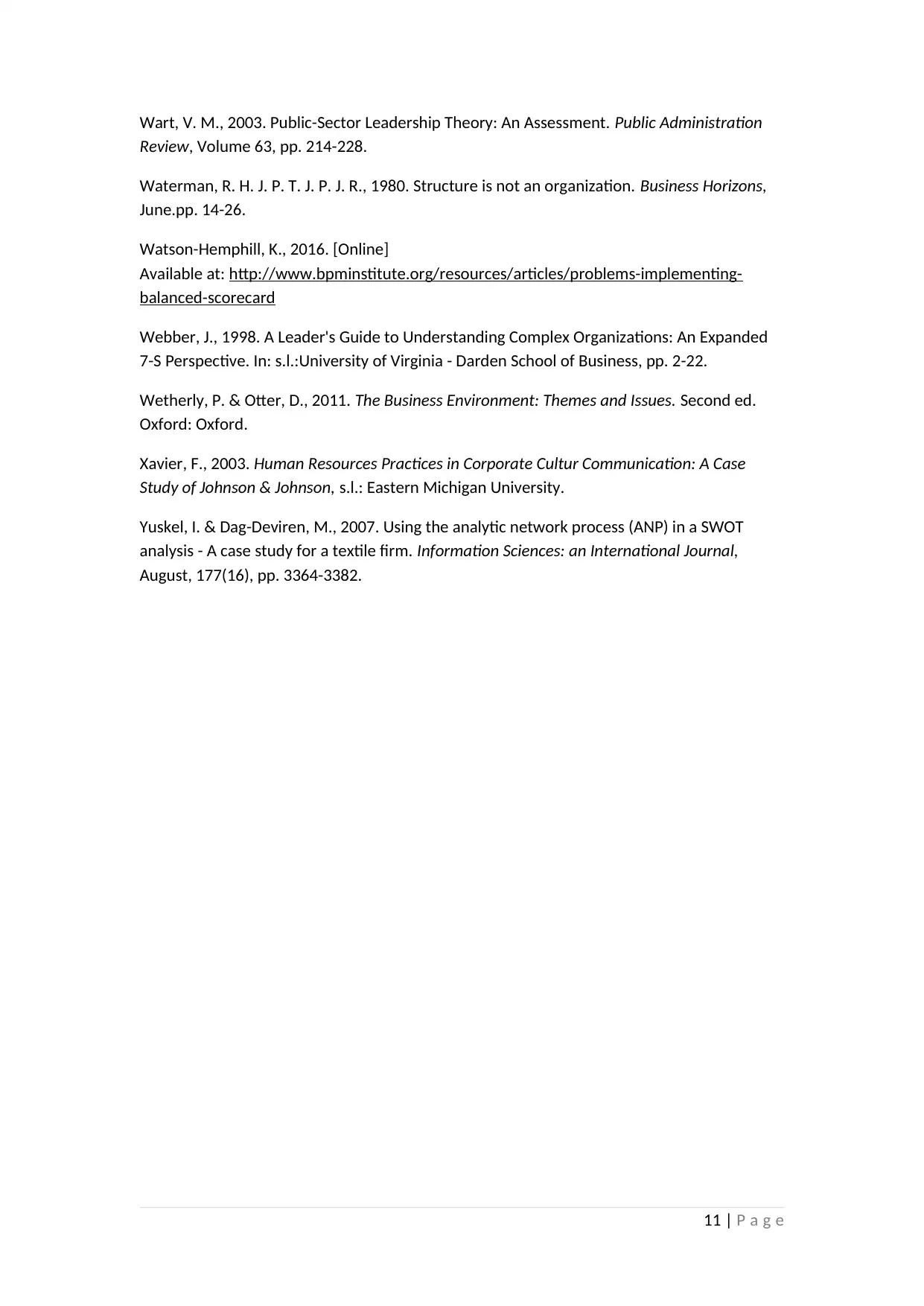
Wart, V. M., 2003. Public-Sector Leadership Theory: An Assessment. Public Administration
Review, Volume 63, pp. 214-228.
Waterman, R. H. J. P. T. J. P. J. R., 1980. Structure is not an organization. Business Horizons,
June.pp. 14-26.
Watson-Hemphill, K., 2016. [Online]
Available at: http://www.bpminstitute.org/resources/articles/problems-implementing-
balanced-scorecard
Webber, J., 1998. A Leader's Guide to Understanding Complex Organizations: An Expanded
7-S Perspective. In: s.l.:University of Virginia - Darden School of Business, pp. 2-22.
Wetherly, P. & Otter, D., 2011. The Business Environment: Themes and Issues. Second ed.
Oxford: Oxford.
Xavier, F., 2003. Human Resources Practices in Corporate Cultur Communication: A Case
Study of Johnson & Johnson, s.l.: Eastern Michigan University.
Yuskel, I. & Dag-Deviren, M., 2007. Using the analytic network process (ANP) in a SWOT
analysis - A case study for a textile firm. Information Sciences: an International Journal,
August, 177(16), pp. 3364-3382.
11 | P a g e
Review, Volume 63, pp. 214-228.
Waterman, R. H. J. P. T. J. P. J. R., 1980. Structure is not an organization. Business Horizons,
June.pp. 14-26.
Watson-Hemphill, K., 2016. [Online]
Available at: http://www.bpminstitute.org/resources/articles/problems-implementing-
balanced-scorecard
Webber, J., 1998. A Leader's Guide to Understanding Complex Organizations: An Expanded
7-S Perspective. In: s.l.:University of Virginia - Darden School of Business, pp. 2-22.
Wetherly, P. & Otter, D., 2011. The Business Environment: Themes and Issues. Second ed.
Oxford: Oxford.
Xavier, F., 2003. Human Resources Practices in Corporate Cultur Communication: A Case
Study of Johnson & Johnson, s.l.: Eastern Michigan University.
Yuskel, I. & Dag-Deviren, M., 2007. Using the analytic network process (ANP) in a SWOT
analysis - A case study for a textile firm. Information Sciences: an International Journal,
August, 177(16), pp. 3364-3382.
11 | P a g e
1 out of 11
Your All-in-One AI-Powered Toolkit for Academic Success.
+13062052269
info@desklib.com
Available 24*7 on WhatsApp / Email
![[object Object]](/_next/static/media/star-bottom.7253800d.svg)
Unlock your academic potential
© 2024 | Zucol Services PVT LTD | All rights reserved.
